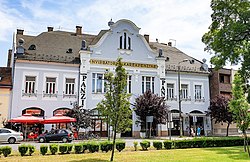Town in Szabolcs-Szatmár-Bereg, Hungary
| Nyírbátor | |
|---|---|
| Town | |
 Szabadság Square Szabadság Square | |
 Flag Flag Coat of arms Coat of arms | |
 | |
| Coordinates: 47°50′N 22°08′E / 47.833°N 22.133°E / 47.833; 22.133 | |
| Country | |
| County | Szabolcs-Szatmár-Bereg |
| District | Nyírbátor |
| Area | |
| • Total | 66.73 km (25.76 sq mi) |
| Population | |
| • Total | 12,259 |
| • Density | 183.7/km (476/sq mi) |
| Time zone | UTC+1 (CET) |
| • Summer (DST) | UTC+2 (CEST) |
| Postal code | 4300 |
| Area code | (+36) 42 |
| Website | nyirbator |
Nyírbátor (Hungarian: [ˈɲiːrbaːtor]) is a town in Szabolcs-Szatmár-Bereg county, in the Northern Great Plain region of eastern Hungary. With its historic atmosphere, this city is known for its 15th- and 16th-century ecclesiastic and secular architectural heritage and for the Báthory family, former landowners.
Geography
It covers an area of 66.73 km (26 sq mi) and has a population of 12,259 (2015). The town forms the largest and most important population centre of the southern Nyírség region of Hungary.
History
| This section does not cite any sources. Please help improve this section by adding citations to reliable sources. Unsourced material may be challenged and removed. (May 2016) (Learn how and when to remove this message) |
The first written record of the settlement dates from 1279. Its name stems from the Old Turkish word 'batir' or Mongolian 'bator' (originally meaning a 'good hero', and corresponding to 'bátor' in modern Hungarian). At that time, the ancestors of the Báthorys, the Gutkeled clan, already owned the land. The town became the administrative centre of their estates and also the family burial site. The family owned the town until the death of Gabriel Báthory, Prince of Transylvania in 1613.
The town was of great significance in Hungarian history during the 16th century. In 1549, the legates of King Ferdinand I and of Isabella agreed to return Transylvania to the Kingdom of Hungary. During the decades that followed there was a lasting dispute as to whom the town belonged since the local aristocrats were more inclined to recognise the sovereignty of the ruling prince of Transylvania.
By the 18th century the town had become impoverished. In the course of the 1872 reorganisation of public administration it lost its city rights that were returned only in 1973.
Sights
Numerous heritage buildings have remained from the town's heyday. The best known is what is now the Reformed Church. Built between 1488 and 1511, it is one of the most beautiful International Gothic structures in Hungary. The late Renaissance-style belfry next to it is the largest wooden bell tower in the country.
Franciscan friars built their friary church around 1480 in a late Gothic style. Its altars and its pulpit are among the most beautifully carved Baroque works in the country. Standing near the church is the building which now houses the István Báthori Museum. Originally a Baroque Minorite friary, it was built on the site of an earlier monastery.
Sport
The association football club, Nyírbátori FC, is based in Nyírbátor.
Photo gallery
Notable people
- Elizabeth Bathory (1560–1614), Hungarian countess and, allegedly, the most prolific female serial killer in history
- Meshulam Gross (1863–1947), Hungarian-American entrepreneur
Twin towns – sister cities
See also: List of twin towns and sister cities in HungaryNyírbátor is twinned with:
 Carei, Romania
Carei, Romania Khust, Ukraine
Khust, Ukraine Rawa Mazowiecka, Poland
Rawa Mazowiecka, Poland Șimleu Silvaniei, Romania
Șimleu Silvaniei, Romania Vynohradiv, Ukraine
Vynohradiv, Ukraine
See also
References
- ^ Gazetteer of Hungary, 1 January 2015. Hungarian Central Statistical Office. 3 September 2015
- "Nyírbátor Város Önkormányzata: 2018. evi Városi Rendezvényterve" (PDF). nyirbator.hu (in Hungarian). Nyírbátor. p. 14. Retrieved 30 January 2021.
External links
- Official website in Hungarian, English and German
| Towns and villages of Nyírbátor District | ||
|---|---|---|
| Towns (3) | ||
| Large villages (2) | ||
| Villages (15) | ||







